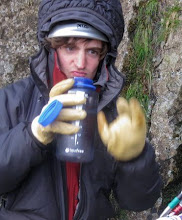Unfortunately, it rained. It rained absolutely all day, in fact, and I got SOAKED. Even a trusty umbrella (I am now a firm believer and can see why all Japanese people carry them) can't keep you dry from rain like that.
Anyway, here are some pictures. Photos inside aren't very interesting so I've just put up a couple of shots of the castle and the hill it sits on.



Of some interest as well was the world's longest suspension bridge, which I passed on the train. I didn't get a photo, because it didn't look anything special, but it's there. Look it up on a map or something - it's a couple of kilometres west of Kobe.
After finding myself a little short of accomodation options in both Osaka, where I was previously staying, and Kyoto, which I wanted to go back to for the sakura, I made a snap decision to leave Kansai behind and head for the south.
One 6 hour bus later, I am in Hiroshima.
First call is probably 'the symbol of Hiroshima' - the A-Bomb Dome (Genbaku Domu) - but first some more Engrish I spotted on a cup in my hotel room. Bizarre.

I'm so relived (sic) it's been washed...
Anyway, the Dome was originally the Hiroshima Prefectural Industrial Promotion Hall. That was until an atomic bomb exploded nearly directly above it on 6th August 1945. The only reason it survived is because it had so many windows, and much of the shockwave blew through it, rather than into solid walls. This is it now.

During the day.

At night, when floodlit.
The next day brought a trip to the Peace Memorial Park and attached Memorial Museum. I won't go on about whether the bombing was right or wrong - you can make up your own mind - so I'll just show pictures.

The Memorial Cenotaph and Peace Flame, with A-Bomb Dome in the background.

Children's Memorial, based on the story of Sasaki Sadako (find out about the story for yourself).

Model of Hiroshima before the bomb (in the Peace Memorial Museum).

Model of Hiroshima almost immediately after the bomb.
While at the A-Bomb Dome on the second day (I passed it to get to the park) I was lucky enough to meet one of the survivors of the bombing, now working as a volunteer guide. He took me to a few sights I might have missed otherwise - the hypocenter (the spot directly above which the bomb detonated) and a small cemetary displaying signs of the explosion.

Building now at the hypocenter (more in a minute).

Gravestones in the cemetery near the hypocenter, showing shadows. The shadows all around the base show that the bomb must have exploded almost directly overhead.
As for the building at the hypocenter, my guide told me a story. Apparently there was originally a hospital standing at this spot. The chief doctor was out of Hiroshima on that day, performing surgery in the countryside, and so he was safe when the bomb was dropped. Similarly, the doctor's son was spared, as he was evacuated to the countryside along with his classmates. Obviously when the bomb went off, the hospital was levelled (save for a single section of wall directly underneath the point of explosion), and everyone inside was killed immediately.
And now? The hospital was rebuilt in exactly the same spot, with the same name. It was run by the same doctor, and when he retired, his son took over and is currently in charge.
Anyway, after a fascinating but quite depressing day, I took yesterday to visit a few places, the highlight of which was the Hiroshima Meteorological Museum. This was, coincidentally, a building that was around before 1945 and survived the bomb.
As well as displays on weather forecasting, etc, the museum has old instruments, and weather charts and sketches from 6th August 1945.

The original sketches of the mushroom cloud.
It also featured 2 hands-on exhibits - a typhoon model, which pumped some kind of smoke into a small room (in which you were standing) and then proceeded to provide rotation and low pressure in the centre, creating a miniature model of a typhoon right in front of (and around) you, and, much to my delight, a wind tunnel in which you could experience winds of about 20m/s (getting towards enough to rip panels from houses).
I will probably never live down the photo I decided to take, but it's too funny not to post.

Wind speed of 20m/s+.
Since I was the only person in the museum I partook of this hilarity about 5 times. It was great.
Moving on, today I took a ride to the Mazda museum, and had an (English!) guided tour of both the museum and a section of the production line. I actually got to see them assembling real cars on a moving line - the new Mazda 2, RX-8 (I want one), MX-5 and something else I can't remember.
There was also a great exhibit on the Mazda Rotary Engine, with lots of moving models, etc, along with explanations of the entire RX-8 production process (including an amazing display of an RX-8 broken down into every single component part (screws and all), labelled and laid out across the floor and walls. I didn't get any photos since they don't like you taking cameras in (for security, I guess) so you'll just have to take my word for how great this was.
Tomorrow I will most likely take a day trip to Miyajima to see the famous 'floating Torii gate', assuming the high tide is right (if it isn't, the Torii is surrounded by mud and not water). But that's something for the next blog, anyway.
Until next time...
James
